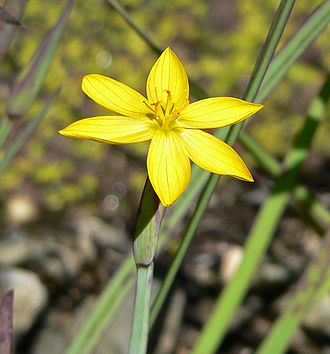
Sisyrinchium is a genus of of about 200 species of annuals and herbaceous perennials native to the New World. The plants are not grasses and are in the iris family, Iridaceae, that also includes gladiolus, crocus and freesia. They tend to grow in grasslands where they produce low tufts of flat, grass-like foliage and star-shaped flowers with 6 blue, purple, yellow or white tepals surrounding a yellow center. Flowering occurs in late spring into summer. Plants like average to rich, consistently moist soil in full sun to partial shade. Many species are short-lived but self-seed. Blue-eyed grasses are best used in informal sites such as cottage, meadow, woodland, native plant, and wildflower gardens. The genus name, Sisyrinchium, may come from the from the Greek sys-, meaning pig, and rynchos , meaning snout, referring to the roots being consumed by swine.
Narrow-Leaved Blue-Eyed Grass (S. angustifolium)
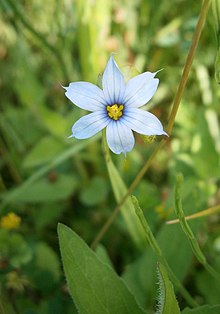
Growing 18-24″ tall, this native of North American moist meadows and woodlands, forms loose tufts of narrow, light green, grass-like leaves up to 12″ long. Flattened, branched, broadly winged stems bear few flowered clusters of star-shaped flowers. The flowers are up to 1/2″ across and have a yellow eye and 6 blue tepals that are tipped with a sharp point.
Height: 18-24″
Bloom Color: Blue
Hardiness: Zones 5-9
Western Blue-Eyed Grass (S. bellum)
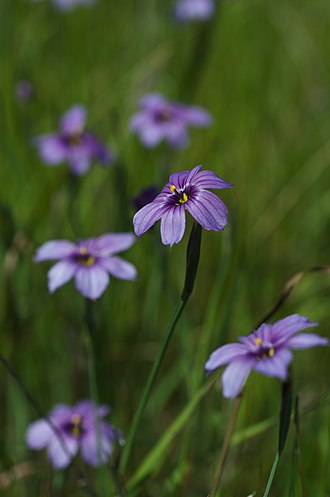
Native to moist grassy areas and woodlands of California and Oregon west of the Sierra Nevada the plants grow up to 2′ tall and forms sparse tufts of blue-green leaves that are 8-10″ long. Flattened, branched, winged stems produce loose clusters of flowers that are 3/4-1″ across and have a yellow center with blue to violet-blue tepals , occasionally white. Western blue-eyed grass is native to moist grassy areas and woodlands of California and Oregon west of the Sierra Nevada.
Height: 3″-2′
Bloom Color: blue, violet-blue, occasionally white
Hardiness: Zones 7-8
Golden-Eyed Grass (S. californicum)
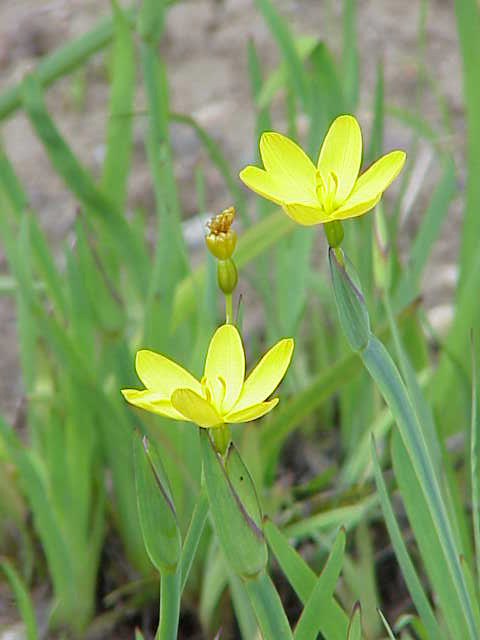
Plant forms tufts of pale green, leaves up to 12″ tall and bear yellow flowers on leafless stems that are flattened and winged. Native to moist soils around ponds, bogs, marshes, and other moist sites along the Pacific coast from central California to southern British Columbia,
Height: 6-12″
Bloom Color: Yellow
Hardiness: Zones 8-10
Argentine Blue-eyed Grass (S. striatum)
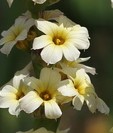
With gray-green leaves ½ to 1 inch wide and up to 18″ long, the plant has flowers in dense erect unbranched spikes twelve to twenty-four inches long, with each spike carrying nine to twelve flowers. The tepals of the flowers are creamy yellow with dark purple stripes on the underside. Plants are native to Argentina and Chile where they grow in alpine grasslands, open woods, and meadows.
Height: 12-24″
Bloom Color: Creamy yellow with dark purple veining on the undersides
Hardiness: Zones 4-8 (plants d not do well in hot climates)
Photo Credits Wikipedia